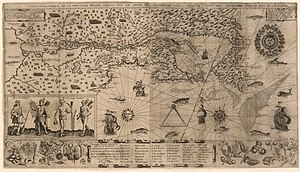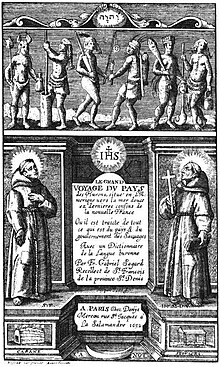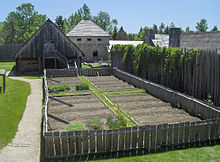Jesuit missions in North America

Jesuit missions in North America were attempted in the late 16th century, established early in the 17th century, faltered at the beginning of the 18th, disappeared during the suppression of the
Establishment of Nouvelle-France and first missions
Toward the end of his reign, Henry IV of France started to look at the possibility of ventures abroad, with both North America and the Levant being among the possibilities.[1]: 43
In 1570, Spanish Jesuits moved northward from San Agustin in La Florida to establish a small mission in Virginia: the Ajacán Mission. On February 19, 1571, eight missionaries were killed by the local Indigenous.[2] The Martyrs have become
In 1604, the French explorer Samuel de Champlain initiated the first important French involvement in Northern America. He founded Port Royal as the first permanent European settlement in North America north of Florida in 1605, and the first permanent French establishment at Quebec in 1608.[1]: 71
First Mission (1609)

The
Second Mission (1611)
The Jesuits wanted to participate in these forays into new lands.
Third Mission (1613)
A third mission was built on Mount Desert Island in 1613.
Fourth mission (1625)
The Jesuits conceived plans to move their efforts to the banks of the
The Jesuit establishment

Although the Jesuits tried to establish missions from present-day Florida in 1566 up to present-day Virginia in 1571, the Jesuit missions wouldn't gain a strong foothold in North America until 1632, with the arrival of the Jesuit Paul Le Jeune. Between 1632 and 1650, 46 French Jesuits arrived in North America to preach among the Indians.[1]: 2
Missions

Viceroyalty of New Spain
In the Spanish colonial
Also, from 1687 to 1704 the Jesuits established twenty-three missions in the Sonoran Desert, in the Provincias Internas of New Spain, present day northwestern Mexico and southern Arizona.
The
New France
In 1634, the Jesuits established a mission in
In 1654, the Jesuits started establishing missions among the Iroquois. In 1656
The Jesuit mission at Detroit was moved to
In the late 1750s, leaders from Kahnawake led 30 families upriver to create a new settlement at Akwesasne, today the largest Mohawk settlement in Canada.
Seminaries
In order to train young Indians to the Catholic faith, a seminary was opened near Quebec, at
Reductions
A more successful endeavour was the establishment of "
: 88One of the most famous reductions was that of Sillery near Quebec, which was established with the financial help of Noël Brûlart de Sillery in 1637.[1]: 88 In 1645, there were 167 aboriginal inhabitants in Sillery.[1]: 105 The reduction was raided by the Iroquois in 1646. In 1670, Sillery was hit by an epidemic of measles and the Montagnais and Algonquins left the territory. In 1698, the Jesuits abandoned their post there as missionaries and transferred the land to the parish of Notre-Dame-de-Sainte-Foy.[1]: 108
Conflict with the Iroquois
The efforts of the Jesuits in North America would be constantly hampered by the conflict of the French with the Iroquois. The Huron Nation was essentially destroyed by the effects of warfare with the Iroquois following
The Jesuits demanded that the Iroquois who converted to the Christian faith also adopt a new approach to politics, thus causing the Iroquois to stop compromising with those who had not converted. They viewed opposition to rituals that bound Iroquois of different clans and nations together as a necessity, since these rituals seemed hopelessly laced with sin and superstition. These differences between the Iroquois converts to Christianity and those that stuck to the traditionalist beliefs created conflicts between the two groups. These led to the traditionalist Iroquois' waging violent attacks on the Christian converts. When the Iroquois spiritual value seemed to increase through war victories, this is what caused traditionalist shamans and headmen to win back disciples in the same way that priest had first won them. In the late 1670s, the wars with Susquehannocks and Mahicans ended, causing the Iroquois to have a return to the perceptions of their own spiritual strength. The Jesuits therefore did not like it when they won these battles, with one Jesuit Father Etienne de Carheil writing that there was nothing more harmful to these missions than the Natives' victories over their enemies.[5]
Further expansion

By 1667 the Jesuits had established a station near present-day
During the late 1690s, the Jesuits expanded along the middle of the Mississippi River, in competition with the Seminary of Foreign Missions of Quebec (a branch of the
: 158Many of the missionaries compiled studies or dictionaries of the First Nations and Native American languages which they learned. For instance, Jacques Gravier compiled the most extensive Kaskaskia Illinois-French dictionary among works of the missionaries before his death in 1708.[8][10] It was not edited and published until 2002, but the work has contributed to the Miami Tribe of Oklahoma's language revitalization project with Miami University in Oxford, Ohio.[10]
In June 1735,
Great Britain took over colonial rule of Canada and the lands east of the Mississippi River in 1763 after the Seven Years' War. In Quebec they allowed the Jesuits to continue to minister to First Nations villages.
The Jesuits maintained a presence until their order was suppressed in France. They were officially expelled from Louisiana in 1763. At that time twenty-seven of them were officiating from Quebec to Louisiana.[9]: 158 After the Order was restored by Pope Pius VII in 1814, Jesuits resumed missionary work in Louisiana from around 1830.[9]: 160
Several Belgian men came to study at Whitemarsh, near Bowie, Maryland, in the early 1820s. They all had volunteered to be missionaries to Native Americans. Father Pierre-Jean De Smet, who started working in Missouri in 1830, would eventually build strong relationships with leaders of numerous tribes of the West, including Sitting Bull, war chief of the Sioux. Through the nineteenth century, Jesuit priests founded missions and schools among Native tribes in present-day Montana and Idaho.
The Canadian residential schools, who caused a detriment to several generations of First Nations children and youth who were silenced and abused within their walls, consisted schools run by Jesuits. The residential schools that the Jesuits took part in functioned in a way so as to bring about indigenous assimilation and to gain their lands. Canadian Ojibwe writer Basil Johnston represents this Jesuit oppression by writing survival humor themes of students at his own Ontario Jesuit-run residential school in the 1930s, while also narrating a more general strategy of resistance by students and their families.[12]
Prior to the
Methods
The Jesuits in America used methods which were comparatively respectful of the traditional way of life of the Indians, especially compared to the approach of the Puritans in New England, who required a conformity to their code of dress and behaviour. In a simplification, the 19th-century Protestant historian Francis Parkman wrote: "Spanish civilization crushed the Indian; English civilization scorned and neglected him; French civilization embraced and cherished him."[16]: 42
Jesuit missionaries learned Indian languages and accepted Indian ways to the point of conforming to them, especially when living among them. According to
The Jesuits were surprised and even indignant toward the Natives' refusal to adapt to what they believed as God's law and nonetheless their continual practicing of what they saw as time-honored customs. Additionally, while attempting to show a commonality between their Catholic faith and the practices of the Native Americans, held some internal frustrations at the Natives refusal to assimilate to the faith rapidly. A prominent French Jesuit, Father Brebeuf, was one priest who tried to find similarities between the cultures, but ultimately decided to fall back to Catholic theistic practices when he couldn't comprehend Native behaviors. With regard to Jesuit Father Francois Le Mercier, he strongly suggested that it was the Natives' having “recourse” to St. Joseph and their vowing to have said a novena of masses which prompted God to save his and Brebeuf's lives and their mission. Le Mercier thus was unable to find a natural explanation, which formed a large part of the Jesuits' writings, for his and Brebeuf's deliverance from danger. This inability is one example that shows how the Jesuits moved beyond the natural explanations and explained events theistically when facing the incomprehensibility of an alien culture.[17]
The concept of going to Hell if one did not convert to Catholicism and the idea that Native practices were evil was a method which the Jesuits used in order to get the Natives to convert. French Jesuit Father Paul Le Jeune, who arrived on Iroquois land in 1632, was one such priest who used this fear tactic. He believed that little by little the Natives would give up their “evil customs.” When Spanish Jesuit Juan Rogel was evangelizing to the Native Florida cacique, or king, in 1565, he told the cacique that the Natives' belief that their ancestors saw God at the time of burials was invalid and that their ancestors actually saw the Devil.[18] In 1600, in the Acaxee territory within Sinoloa, Mexico, Jesuit Father Alonso Santaren, alongside Captain Diego de Avila, used physical punishment and in at least one case, execution, to root out the practices that they believed allowed Satan to maintain a hold on the Indian mind. On December 7, in an attempt to find hidden idols or piles of bones, Diego and Santaren discovered skeletal remains in houses and then placed them in a pile in the center of the village. Before burning the idols and forcing the Natives to watch this, Santaren commanded a guard to give four lashes to an old Native man who refused to hand over his ancestral bones.[19]
The Spanish Jesuit missionaries in New Mexico did not prepare themselves for missionary groups with different language groups. The Natives were also required to provide entertainment to the Jesuit missionaries in their villages. Additionally, the Natives were given no period of request for missionaries, wherein they could have been prepared by their leaders to receive the missionaries. There was a forced labor program that both the Spanish government and Jesuit missionaries imposed on the Natives. This forced Native people to assimilate to not only Jesuit customs, but Spanish life in general, including the family ways and morality of the Spanish colonists.[20] In Mexico, the Jesuits were complicit the mistreatment of Afro-Mexicans, or people of mixed African and Native Mexican blood, which was waged by pure Native Mexicans. Although the pure Native Mexicans were likely also oppressed by these and/or other colonial forces, Native Mexicans that also had African blood mixed in are the ones who suffered harder. Located in Xalmolonga within the Toluca region, the Jesuits held the most notable concentration of slaves in Mexico here. The Jesuits treated them with the same reputation of illegitimacy as the pure Native Mexicans did, which came from being born out of wedlock or being born of illegitimate unions.[21]
Spanish Jesuit missions in North America
- Spanish missions in Arizona
- Spanish missions in Baja California
- Spanish missions in the Sonoran Desert
- Franciscanmission program
See also
- Jesuit history in Central and South America
- Franco-Indian alliance
- List of Jesuit sites
- List of Spanish missions
- Jesuit China missions
- Eusebio Kino
References
- ^ ISBN 2-7475-1123-5.
- ^ Jesuit Martyrs of Virginia
- ^ National Catholic Register
- ^ Ontario Heritage Trust Jesuit Mission to the Hurons Archived March 20, 2012, at the Wayback Machine
- JSTOR 482090.
- ^ ""Jacques Marquette", Biography". biography.com.
- ^ ISBN 978-0-252-06924-6.
- ^ .
- ^ ISBN 978-0-19-530071-0.
- ^ a b Costa, David J.; Wolfart, H.C., ed. (2005). "The St-Jérôme Dictionary of Miami-Illinois" (PDF). Papers of the 36th Algonquian Conference. Winnipeg: University of Manitoba. pp. 107–133. Archived from the original (PDF) on July 27, 2011. Retrieved March 7, 2012.
{{cite web}}:|first2=has generic name (help)CS1 maint: multiple names: authors list (link) - ^ "Biography – AULNEAU, JEAN-PIERRE – Volume II (1701-1740) – Dictionary of Canadian Biography".
- ^ Child, Brenda. "The Boarding School as Metaphor". University of Oregon.
- ^ Rothman, Adam (2021). "The Jesuits and Slavery". Journal of Jesuit Studies. 8: 1, 5–9. Retrieved 25 August 2023.
- ^ Swarms, Rachel L. (April 16, 2017). "272 Slaves were sold to save Georgetown". The New York Times. Retrieved 25 August 2023.
- ^ Company, Tampa Publishing. "St. Peter Claver celebrates 125th anniversary with inclusive congregation". Tampa Bay Times.
- ^ ISBN 0-313-32168-X.
- JSTOR 2674530.
- JSTOR 1185790.
- ^ CUSHNER, NICHOLAS (2002). THE JESUITS IN COLONIAL AMERICA: 1565-1767. Buffalo, NY: Language Communications.
- JSTOR j.ctv1220r6w.12.
- )
Further reading
- Greer, Allan (2000), The Jesuit relations : natives and missionaries in seventeenth-century North America, Bedford/St. Martin's, ISBN 0-312-16707-5
- Hughes, Thomas (1917). History of the Society of Jesus in North America. Vol. 2. Bedford, Massachusetts: Applewood Books. ISBN 978-1-4290-1833-3. Retrieved August 29, 2012.
- Kip, William Ingraham (1846), The early Jesuit missions in North America, New York: Wiley & Putnam, retrieved August 29, 2012
- Masthay, Carl, ed. (2002). Kaskaskia Illinois-to-French Dictionary. St. Louis, Missouri: Carl Masthay. p. 757. ISBN 0-9719113-0-4.
- Parkman, Francis (1867), Jesuits in North America in the Seventeenth Century, ISBN 9781606800171
- Roustang, François (2006), Jesuit missionaries to North America : spiritual writings and biographical sketches, Ignatius Press, ISBN 9781586170837
- Schroth, Raymond A (2007), The American Jesuits: a history, New York University, ISBN 978-0-8147-4025-5


